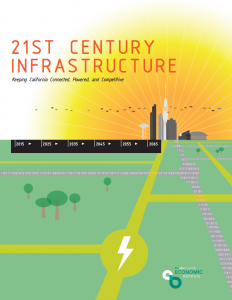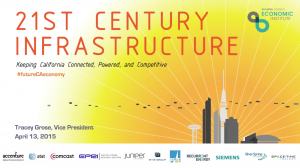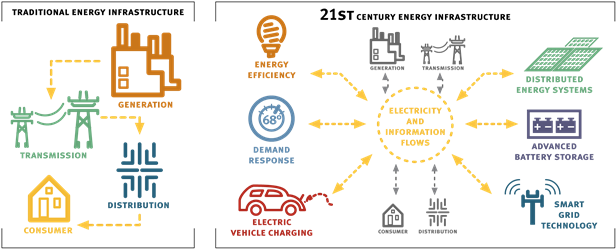Recent advances in energy and communications technologies have outpaced anything the human race has seen since either the invention of the telegraph or the discovery of alternating current. Many of these advances have enabled technologies that were once the realm of science fiction—driverless cars, implanted medical devices, and vast supplies of renewable energy.
Today, these and related technologies are shaping up to be as important to California’s prosperity in the 21st century as roads and waterways were in the 20th. However, the pace of innovation is increasingly pushing up against the physical constraints of California’s legacy energy and communications infrastructure. Without upgrading to 21st century infrastructure, California will not keep up with the level of competition and the rate of change in today’s global economy.
Read the press release announcing the report>>
21st Century Infrastructure (REPORT)

21st Century Infrastructure (PRESENTATION)
Keeping Pace
California’s regulatory structure for dealing with these challenges was designed in the mid-20th century, when many of today’s technologies and economic drivers were unheard of, and deliberative processes could take years. But today’s technologies are advancing with blinding speed and their implications are being felt immediately, with rapid adoption by both businesses and consumers. Other nations are moving quickly to embrace this new paradigm by adapting their regulatory processes to enable the development of advanced infrastructure for both communications and energy. California also needs to embrace a dynamic vision of the future, and accelerate and adapt its policies and processes.
The Bay Area Council Economic Institute today (April 13) released a new report – 21st Century Infrastructure: Keeping California Connected, Powered and Competitive – that examines California’s readiness to support 21st Century Infrastructure and recommends new approaches to managing the exploding growth of digital technologies consumers and businesses are demanding and the rapid changes in how the state produces, stores and delivers energy to its 37 million residents.
California’s ability to adatp to these rapid changes will impact the competitiveness of its businesses and the quality of life of its citizens. The results can be transformative, but only if California invests now in the technology and infrastructure that will lead it into the 21st century.
Communications recommendations
- Allow private-sector use of new and existing public conduits to co-locate communications infrastructure.
- Expedite local review/permitting process by reclassifying communications as public works in municipal codes.
- Allow “blanket” permitting for multiple projects within a municipality.
- Provide greater regulatory clarity with new technology-neutral framework.
- Create a statewide Advanced Networks Task Force to develop new models for enhancing and managing California’s communications.
Energy recommendations
- Develop new rate structures to account for distributed energy supplies.
- Embrace new energy storage technologies.
- Promote more robust integration of electric vehicles into the power grid.
- Expand the use of data to manage energy networks.
- Transition to more decentralized model for utility management of energy networks and possibly broader supply of energy services.
What’s Driving the Change
The recommendations are informed by the lightning-fast changes taking place in the products, services and methods that consumers and businesses are using to communicate with each other and the world. Consider just a few jaw-dropping statistics included in the report that vividly illustrate the scale and speed at which change in the communications sector is occurring:
- Monthly Internet traffic has increased by a factor of 450,000 since 1995
- Global mobile data grew by 81 percent in 2013, following a 70 percent jump in 2012
- By 2018, there will be 2 billion connected devices, from wearable technologies to industrial sensors
- Global annual cloud storage is projected to increase 300 percent between 2013-2018
- California leads nation in smart energy meter deployment, with 12 million in use
- California electric vehicle sales lead the nation, with 40 percent of total
- 13 percent of California electricity comes from renewable energy, far exceeding 4 percent nationally








